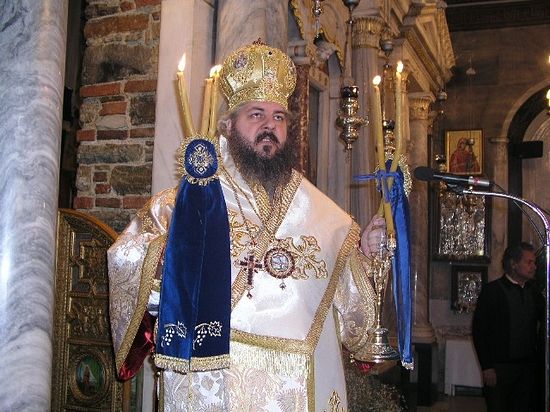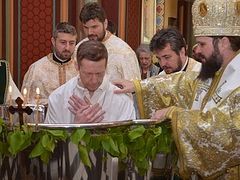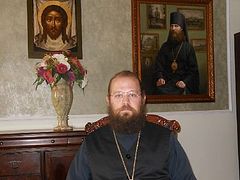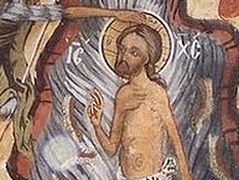Source: Orthodox Metropolinate of Hong Kong and South East Asia
March 13, 2016
Church and Mysteries (Sacraments)
The Church is not a “human” organisation, but a God-man organisation. It is not a human association, but the Body of Christ the God-man.
Whatever happens within the Church is filled with the grace of God and the whole of life within the Church is blessed.
In the Orthodox Church there are commonly understood to be seven Mysteries (Sacraments).
We call them Mysteries (Sacraments) because they are God-established rites, in which through outward visible signs the invisible cleansing and holy-making Grace of God is imparted.
These seven Mysteries are: Baptism, Chrismation, Holy Communion, Confession, Ordination, Marriage and Holy Unction. The first four are incumbent upon every believer, while the other three are a matter of choice.
However there are three basic Mysteries of the Church: Baptism, which is called the introductory Sacrament, through which we are initiated into church life; Chrismation, which is the seal of the gift of the Holy Spirit; and Holy Communion, through which we commune of the Body and Blood of Christ.
St Nicholas Cabasilas says that Baptism is the spiritual birth of man, Chrismation is movement (the movements that activate grace), and Holy Communion is life (the New Life that Christ inaugurated with his Passion and Resurrection).
The Mysteries are the channel through which we receive the water of the Grace of God the Holy Trinity; and of course we participate in the gifts of God depending on our spiritual state.
Our participation in the Mysteries requires certain preconditions, which are belief in the divinity of Christ and our salvation, spiritual preparation, and the sense that we are members of the Church of Christ.
The Mystery of Baptism
Baptism is the introductory Mystery of the Church. It incorporates the person – of whatever age – into the Body of Christ, the Church, meaning that they can call themselves a Christian.
The word ‘baptism’ itself means plunging into water. In the Christian tradition going down into the water depicts symbolically going down into the tomb with Christ, that is participation in his death, while emerging from the water expresses the overcoming of death, that is resurrection together with the Lord, which is the birth of a new man. “He saved us through the washing of rebirth and renewal by the Holy Spirit” (Titus 3:5).
The Mystery of Baptism was established by our Lord Jesus Christ himself with his command to the Disciples to baptise in the name of the Father, the Son and the Holy Spirit (Matt. 28:19). Christ himself was baptised and his Baptism became the type and model of our own Baptism.
The aim of Baptism according to St Basil the Great is two-fold: firstly to abolish sin, which leads to death. This manifests the essential deliverance of man from corruption and death that was inherited through sin (the failure) of Adam and Eve. Therefore Orthodox Tradition rejects moralistic stances on the deliverance of man from the guilt of Original sin.
Through Baptism man is offered the foundations to build his life in a new community of life, with Christ as its head, and with all Christians as the members, signalling a journey of ascetic effort and progress into the gift of the Holy Spirit of freedom and love.
The fundamental condition and the wider framework of the mystery of Baptism is the universal divine Economy of salvation, covering the creation of the world and man, the sinfulness and fall of man, and in particular, the salvific work of Christ, which is the Incarnation, Death and Resurrection, as well as Pentecost – the descent of the Holy Spirit.
More specifically, for someone to understand the Orthodox stance on Baptism, he or she must keep in mind the creation of man according to the image and likeness of God, that is an open Christian anthropology, based on which man is a dynamic being in the image of God, open towards life, immortality, theosis or deification, and communion with the Triune God.
Through sin, this dynamism of the movement towards God was interrupted and man fell into an abnormal state, which is corruption and death. His fall, however, is not final. From this event the possibility of salvation emerges, and of his return to his original destination. And this takes place through the salvific work of Christ: his Incarnation, Baptism, Crucifixion and Death, his glorious Resurrection and the gift of the Holy Spirit, the founding of the Church as a new reality, as a new way of being and life.
As we have mentioned, Baptism is called the ‘introductory Mystery’, because through it we are introduced into the life of the Church and we become members of the Body of Christ and at the same time members of the Church.
Baptism is also called a ‘re-birth’, because through this we are re-born spiritually. Man is born twice, once biologically from his mother and secondly spiritually from his spiritual mother, the Church. In both cases there is a womb: in the first case it is the mother’s womb, and in the second it is the spiritual womb which is the baptismal font.
Through Baptism we are born into a new life, we acquire the possibility of spiritual growth, our image according to God is cleansed and we are able to attain to the divine likeness. Through the grace of Baptism we are able to pray and call God Father and other people our brothers and sisters. We are able to face the workings of the devil, we are able to receive Holy Communion and of course, depending on our spiritual state, we can fulfil the aim of our creation.
The Ancient Roots of Baptism
According to St John Damascene, the Church is the whole of creation.
The Mysteries have existed throughout history since Old Testament times, since the beginning of Creation, in order to grant life and healing. Besides, throughout the whole of the Old Testament, the Son of God is present as the unincarnate Word. Through the incarnation of God the Word we enter into a new phase, that of complete healing and grace, yet the energy of the Mysteries is always necessary for the Church-creation, in order for God’s creatures to exist, to be sustained, and to be made perfect.
This is the reason why St John Damascene tells us that there are many kinds of baptism, beginning from Old Testament times and culminating in the New Testament with the incarnation. The first baptism is Noah’s Flood, which brought an end to sin. The second baptism is when Moses struck the waters with his staff, the waters moved aside, and the Israelites were saved. And the third baptism is the legal baptism that every impure Israelite underwent.
The fourth baptism is the baptism of St John the Baptist, which precedes the baptism of the Lord. The fifth baptism is the baptism received by Christ himself, not of course because he needed to be cleansed but in order to sanctify the baptiser, to reveal the mystery of the Holy Trinity and for it to become the type and model for us also. This baptism overshadows all the others, because it sanctifies the baptiser completely, as well as the whole of humanity, and it reveals the mystery of the Holy Trinity.
We see that baptism has very ancient roots, from the beginning of creation, and it did not appear for the first time with Christ’s baptism in the river Jordan. Christ’s Baptism in the Jordan is the culmination of the sanctification granted by baptism.
The Rite of Baptism as celebrated in the Orthodox Church nowadays
In the early Church people were baptised when adults. Their catechism lasted for three years and they would be baptised all together at Easter.
Infant baptism became the norm in the sixth century and the task of catechism fell upon the Sponsor and the parents together with the priest of their community.
The rite of Holy Baptism, as it is celebrated nowadays, is divided into three parts:
a) The prayers before Baptism
b) The main service of Baptism
c) The prayers after Baptism
During the first centuries of the early Church these services were conducted separately, in the order given above. Later, around the time when infant baptism became the norm, they were joined together, and that is why we celebrate them as one rite today.
At the beginning of the Service of Catechism, the priest, together with the person to be baptised, the applicant, and his or her sponsor stand in the narthex or in the western part of the church, in the place that symbolically represents the fact that now begins the entrance of the applicant into the Church. They turn to the west (which symbolises the kingdom of darkness), where the renunciation of Satan takes place. There, the priest, vested only in his stole (epitrachelion), reads some prayers through which he prays that the future new Christian may live always under the protection of God and according to His Will.
After this the priest orders the devil, in the name of God, to depart far from the person who is about to become a Christian. Let us not forget that there is no neutral state, which might suit us. We are either close to God or to the devil. Of course every person, baptised or unbaptised, is a creation and image of God. But when we are far away from God the devil considers that he has more rights over us, and that we belong more to him. It is neither therefore insignificant nor purely a matter of formality that the priest, at the end of these prayers, blows three times onto the face of the person, uttering the prayer that every evil spirit depart from within him or her. Likewise, the priest asks the person himself, or, in the case of infant baptism, the sponsor, to spit three times, having first stated that he or she renounces the devil. It is important that we realise how important it is in our lives to have really renounced the devil, to really despise him and all his works. Otherwise, how can we say that we are Christians? After having renounced the devil, they all turn to the East (symbolising the Kingdom of Christ) and the applicant confesses that he will journey with Christ from now on. The priest asks, ‘Do you unite yourself to Christ?’ and the applicant answers ‘I unite myself.’ And as a sign of what exactly he believes in, he recites the Creed, the Symbol of Faith.
After these pre-baptismal prayers, that as we saw are a preparation for someone to receive the grace of Holy Baptism, the Baptism service itself begins. Now the priest stands in the centre of the church, near to the font, together with the applicant and the sponsor, wearing his stole and phelonion and he says: “Blessed is the Kingdom of the Father and of the Son and of the Holy Spirit, both now and for ever and unto ages of ages, Amen.” This phrase, which is a doxology to the Triune God, reminds the applicant that through Baptism he is about to enter the Kingdom of God.
Straight afterwards we hear the priest intoning the petitions, and he prays for the whole of the Church, and above all for the one who is to be baptised. After yet another beautiful prayer for the spiritual growth of the applicant, we have the prayer of the blessing of the water of the font. This prayer is followed by the blessing of the oil. This oil, symbol of the struggle for healing, the remission of sins, of reconciliation, is spread all over the body of the applicant.
We now reach the most fundamental moment of the whole service, which is the going down into the sanctified water three times. Each time the person goes down into the water the name of one of the persons of the Holy Trinity is heard. Going down three times into the water signifies the three-day burial and resurrection of Christ, and they are not simply symbolic movements. From this very moment the baptised person has become a member of the body of Christ. As Christ died and was resurrected, so also through the power of the Holy Spirit, who acts within the Church, the one who is baptised dies as one far away from God and is born as one united to God.
The prayer of Holy Myron or Chrism follows. The priest thanks the God Almighty, who in his desire for all to be saved fills us with the gifts of the Holy Spirit. Of these gifts a visible sign and seal on us is the anointing with the Holy Chrism. Once the newly baptised has been anointed with the Holy Chrism in the sign of the cross, on different parts of the body, he is now a new Christian, a whole, shining icon of God, and we pray that he may keep this wholeness throughout his life. And as a tangible and material sign of his light-filled and holy life, he is dressed in white clothes, and the prayer is recited that he may live “clothed” in righteousness and the light of Christ. The priest places the cross around the neck of the newly baptised person, for this cross is the symbol of Christian identity and presents him or her with the lighted candle, which reveals the expectation that the new life of the baptised will be filled with the light of Christ.
The priest, baptised member and sponsor then process round the font. This procession is a spiritual “dance”, an expression of joy and rejoicing in the fact that one more person has received salvation. These are the first steps of the baptised person as a Christian within the spiritual family of the Church.
The service of baptism is completed with the readings of the apostle and the Gospels, and some Eucharistic prayers.
The Church will emphasise to its new member that baptism allows everyone to be granted remission of sins, but the grace of the Holy Spirit is granted according to the extent of one’s faith and the spiritual struggle for purification. Through Baptism we are given only the beginning of life in the Holy Spirit and another life full of light. The Christian must strive to keep himself pure from sinful works so that he does not once more become a slave of sin. Just as works without faith are dead, so also faith without works is dead.
I will complete my talk with an extract from a poem by St Ephrem the Syrian, which is dedicated to newly-baptised Christians.
20. Great is the victory, but today you have won:—if so be ye neglect not, you shall not perish, my brethren.
21. Glory to them that are robed, glory to Adam’s house!—in the birth that is from the water, let them rejoice and be blessed!
22. Praise to Him Who has robed, His Churches in glory!—glory to Him Who has magnified, the race of Adam’s house.
(Hymn XIII. Hymn of the Baptised. Saint Ephrem the Syrian)




